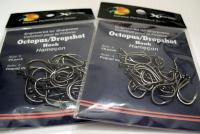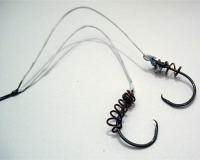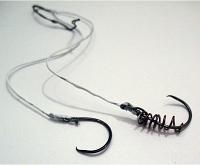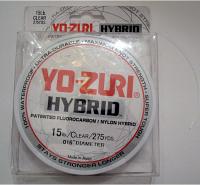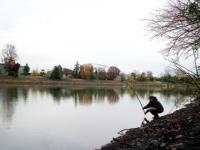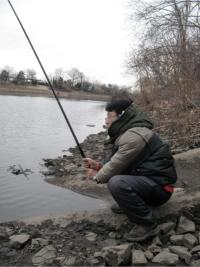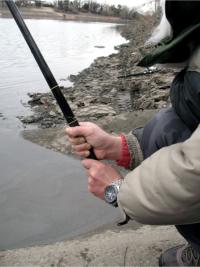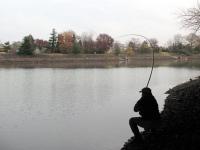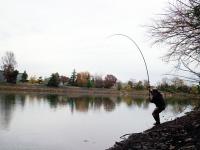Our customers tips, important aspects of pole fishing, hera fishing, tenkara fishing
It is very important for us to hear the opinions of our customers as we are always striving to meet all their needs and improve our products while providing the best customer service and offering best prices. We are working hard to make our web site extremely useful and helpful to a every fishermen, beginner and professional alike. We placed lots of information about Hera, Pole and Tenkara fishing, but If you are a beginner maybe it's a little overwhelming information to read and connect that information to the reality. You always have to modify your setups ( hooks, leaders and baits ... ) for the location where you fish, for the sizes of the fish you are trying to catch.
We will try to describe the most important aspect of pole fishing: How to pull out and push in the rod, How to set up rod with rod holder, How to cast, How to pick up, How to set the hook, and How to play and land the fish.
Carp fishing with Hera rod or Pole
Many of our customers are very interested in carp fishing and while everyone is using one's own ways it would be very helpful to know the setup that was used by our customer Todd to catch the winner. We are very glad to share with everybody his great experience catching such monsters.
From Todd: I'll be more then happy to share my experience with other anglers.
First, because of size of the fish that we deal with here, everything has to be strong. Through many tries and error, we kind narrow down to a simple methods and stay with them.
Baits:
Sweet corn right out of the can or Bread balls ( Wonder bread ).Hooks:
I have tried many and different types but it comes down to these three kinds.
They hardly break and bend out.
- GAMAKATSU Hook: Size #4 and #2 octopus circle hook
- OWNER Hook: Size #4 and #2 SSW straight eye
- Basspro Shop Hook: Size 34 and #2 XPS octopus/dropshot ( my favorite)
Fishing line:
- YO-JURI Hybrid fluorocarbon 15lb.
- SEAGUAR Carbon Pro fluorocarbon 15lb.
Floats:
Any float will work if you are after carp. The carp takes the bait and runs with it. Many times people lost there rod, we call it "Rocket lunch". It is good idea to have rod tie down. Using a Rod Holder is the best to prevent of loosing your rod with carp runs or destroying or damaging it. If you are after crusian carp, you will need carefully balance the sinker to the float, because there bite is very delicate.Landing a monster carp:
Helpful Tips for Hera rod fishing:
"Do not raise the rod up high with fish on end of line" The tip can break!!!! Not like Pole rod, Hera rods are stiff, so If you bend the tip more then it can handle, it could break very easily. This problem will not happen with Pole rod. It is very different type of rod. For the crusian carp, it's better with pole rod, but you just don't know what lurking underneath the water, so go with Hera rod and as a result:
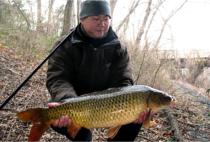
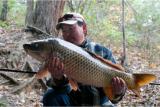
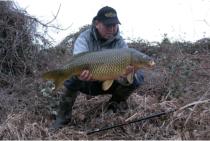
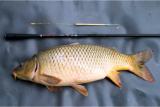
Back to top
Trout fishing with Tenkara rod
Tenkara has become very popular in the USA and around the world in the last year. Part of the joy of Tenkara fishing is the simplicity and thus going to the stream with only a rod, furled or level line, a spool of tippet, a small box of favorite flies, a pair of nippers, and some hemastats can be very addictive.
Thank you, Randy, for your extremely grateful advice, your time and generosity that has been of incredible value to all our customers.
In experimenting with this style of fishing I have tried several different kinds of lines with varying degrees of success depending upon the flex of the rod and type of fly used. Traditionally, Tenkara in Japan is performed on smaller free flowing mountain streams that are not surrounded by a lot of brush and trees. These streams tend to be faster than lowland streams, and thus the fish must react quicker in taking a fly. On these types of streams tapered furled monofilament or fluorocarbon lines a foot or two shorter than the rod seem to work well. A 2 to 4 foot tippet of light weight (usually 5lb or less breaking strength for most Tenkara rods) tippet is attached to the end of the line by using either a loop to loop connection or in some instances by tying it to a small 2mm to 3mm tippet ring built into the end of the furled line. Currently there are five other kinds of lines in use: level fluorocarbon or mono lines, hand knotted tapered mono or fluorocarbon lines following traditional leader formulas, hand tied twisted and knotted lines using multiple strands of high quality horse tail hairs or horse tail hair substitutes, ten foot tapered floating poly leaders or other long manufactured tapered leaders, and finally lengths of light weight tapered or traditional fly line of 0wt to 1wt. All these lines are attached either by a slip knot or hitch to the lillian that extends from the tip of the Tenkara rod.
In fishing these smaller freestone mountain streams the longer length of the Tenkara rod and a light line choice enables the Tenkara fisher to cast the fly and then hold most if not all the line off the water surface so that the drift of the fly can be drag free and often be held across stream to the other side of a fast seam normally inaccessible to a normal fly rod and line user unless he crosses to the other side. This is because a heavier line is pulled by gravity underneath the tip of the rod toward the caster resulting in the line being dragged across the water surface which in turn soon drags the tippet and the attached fly. This is true for the Tenkara fisher also if too heavy a line is used. When using heavier nymphs and streamers this may be less important unless you are drifting the weighted flies close to you with the rod held high as in Czech nymphing. I have tried different line systems but usually choose to fish a furled line unless it is very windy in which case I might use a level section of 15lb test fluorocarbon or a level section of 17lb mono.
When fishing Tenkara rods on waters in a less traditional setting such as larger rivers, lakes, or ponds, the line used can vary depending upon the size, weight, and number of flies being cast and the total distance of the intended cast. Some Tenkara fishers have successfully fished with line-tippet combos out to 40ft with Tenkara rods, but this is not traditional Tenkara fishing. In such cases other telescoping carbon rod/poles of longer lengths and heavier construction are more suited. I have used Allfishingbuy carbon poles and Hera poles in Tenkara style fishing by using heavier line configurations to accommodate larger and heavier weighted flies rather than the bait used by most long pole fishers. In this way flies can be cast using longer and stronger rods maintaining the ease and simplicity of Tenkara in a non traditional manner.
The "puppy drum" in my gallery picture was caught using a hand tied 12ft line starting at 40lb test mono and tapered down to 15lb test mono. To this I attached 4ft of 12lb or 15lb test fluorocarbon tippet. I was using a 1/8 oz hand tied charteuse marabou jig. I have used traditional floating and sinking fly lines with the same Hera rod as well as with my 15' Hera-B1-914-2-3604 and 21' Hera-B1-905-2-6306 rod/poles also with the idea of casting flies with more simplicity than a standard fly rod and reel. I have done the same with my Allfishingbuy 12' A1-53-1-3608 carbon pole for tossing small foam spiders and poppers to bass and bluegill. Fly fishing can be done with almost any style and length of telescoping pole but it is not really traditional Tenkara when you get away from small mountain streams.
Traditional Japanese Tenkara flies are usually very simple and easy to tie and very effective on smaller streams. Because of the quicker reaction forced upon the fish by faster moving water, the fly used becomes less important and a simple fly tied with only thread and a reverse hackle (forward leaning rather than straight up or aft leaning for more action) can be very effective. Likewise, a simple floating fly like an elk hair caddis imitation may be all one needs. For nymph fishers, a smaller beadhead hare's ear or other favorite will be enough.
If you take your Tenkara rod to a larger river, lake, or bass pond then a fuller range of flies may be necessary to match the hatch or attract bigger fish or species other than trout, but that is not the intended purpose for traditional Tenkara fishers. Part of the joy of Tenkara fishing is the simplicity and thus going to the stream with only a rod, furled or level line, a spool of tippet, a small box of favorite flies, a pair of nippers, and some hemastats can be very addictive. Some may choose a small landing net but many do not. Most Tenkara fishers don't even use fly flotant, and because of the long rod reach even hip waders are often left behind.
Helpful Tips for Tenkara rod fishing:
Generally, I make my tippet 3 to 5 feet longer than my line and my line the same length or slightly shorter than the rod. There is no rule. It is just easier to land the fish if the line and tippet combo is not too long. If the fish can be lifted easily with the rod then a tippet that is only a few feet longer than the rod will enable you to lift the fish out of the water and have it come right to your hand or net. If the fish is too heavy than you are probably going to grab the line to bring in the fish after it is tired. I usually fish with a line tippet combo that is no longer than 1 1/2 times the length of the rod. If I am fishing a small stream with overhead obstructions like tree branches, then I might choose a line leader combo that is the same length or even shorter than my rod.Allfishingbuy fly fishing line is a soft pliable level line with very little memory and does not twist when removing snags. It is a line much like the thin running line used by fly anglers who want a thin light line to follow a heavier section of weight forward line or shooting head. It loads a tenkara rod similarly to the way a traditional fly line loads a traditional fly rod. It has some stretch to it which helps to protect the lighter tippets used in tenkara fishing.
The fluorescent yellow version is probably the most visible tenkara line available and greatly aids the presentation process in all light conditions. This is because the angler can follow the line easier and therefore know where his/her light tippet and fly are on or in the water. The brighter line also enables the angler to detect strikes better because the end of the line is easily seen in and on the water and will move suddenly when a fish takes the fly much the same as a strike indicator. The 10lb test version is best suited for situations not involving heavier weighted flies and non-windy situations. The 15lb lines are heavier and turn over heavier flies easier and help the angler cast in windy conditions. This is a great line that does not twist or tangle when snagged.
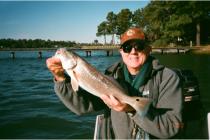


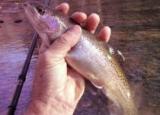
Back to top
Trout fishing with Tenkara Universal rod
Tenkara Universal Rods are the same as traditional Tenkara rods are very easy to use, but they are longer and more powerful. They allow anglers to cast farther, mend easier, and better control a drifting fly and as a result help catch more fish and a bigger fish such as Steelhead Trout, Atlantic Salmon, or even big Striped Bass.
Thank you, Donald, for your extremely grateful advice, your time and generosity that has been of incredible value to all our customers.
I had a great fishing trout day today using the Hamachi rod, the
10 lb running line you sent me and the
EZ hook holders. I landed 10-15 browns and rainbows between 12 and 16 in, and the rod had no problem. Your description of the strength of universal tenkara rods is accurate. I used 11 ft of the 10 lb line and 4 ft of 5x tippet you sent me and it cast like a charm. No real problems even in wind.
BTW, one thing tho, because of a tenkara rod's flexibility, one has to tire out the fish longer to net it and thereafter must keep the fish underwater as much as possible while disengaging the fly and then hold it underwater until it recuperates enough to swim away. This may cause fish recuperation problems in the summer when the water is warmer and holds less oxygen.
Back to top



